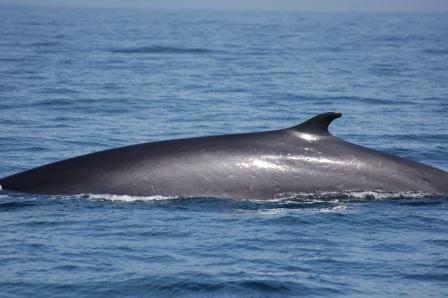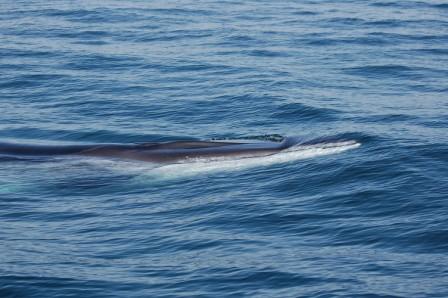
Photo credit: Gordon Gates
Second place is such a drag. It means that first place just got away. It means that you were almost the champion. It means that no one gets to hear your national anthem blast during the Olympics. And well let’s face it, second place finishers tend to be forgotten.
But what’s that annoying phrase told to red ribbon receivers? Winning isn’t everything. And in the case of the fin whale or Balaenoptera physalus that’s the truth. As the second largest animal in the world, the fin whale must forever live in the shadow of the blue whale’s greater size and girth. Hence the reason the fin whale isn’t very well known because gaining recognition as the second largest whale just doesn’t work.
Yet there are so many wonderful fin whale characteristics it’s hard to believe that “second largest animal in the world” is the standard story lead. So let’s get the statistics out of the way and be done with it. Fin whales in the northern hemisphere average 75 feet in length and weigh 40 to 80 tons. Pretty impressive second place numbers.
But what’s even more extraordinary considering their massive size is the fin whale’s speed. They are known as the greyhounds of the sea, or as Bernardo Alps, president of the American Cetacean Society’s Los Angeles Chapter (ACS/LA), more accurately describes, “the cheetahs of the sea.” Fin whales are one of the fastest baleen whales with the ability to travel up to 20 knots (23 mph). What’s that blue whale, you’re not up for a race? Suddenly feeling tired?
And just like cheetahs, fin whales have sleek, hydrodynamic bodies featuring a natural paint job that puts NASCAR to shame. With dark gray, almost black coloring on their backs and glistening hints of green, fin whales provide a spectacular whale watching opportunity even if you only see their back and superbly curved dorsal fin. Even cooler though is the asymmetrical coloring along their jaw, featuring slate gray on the left side and white on the right.
Fin whales really put a lot of extra work in designing their right side because the baleen is also two different colors. The front third baleen plates on the right is creamy white while the rest is black, a nice contrast to the white jaw. And gray swirls of color accent the top right side of the head. According to the Guide to Marine Mammals of the World, this flair of grays is referred to as the “blaze.” And as if the blaze wasn’t enough, “many individuals have several light-gray, V-shaped ‘chevrons’ behind their head,” according to NOAA’s National Marine Fisheries Service website.
Underneath, fin whales are a smooth white; the paint color would probably be called “linen” or “lotus,” natural and easy on the eyes. It’s not clear what all this fancy artistic design work is for. It’s helpful for research because the unique blaze and chevron patterns in conjunction with the size and shape of the dorsal fin allow scientists to identify and track individual fin whales.
The asymmetrical coloring on the jaw could have a more practical purpose. “Studies have shown that cetaceans use light colored body parts to startle and herd prey,” said Alps. “The two-colored lower jaw would allow fin whales the choice to either flash schools of prey or to approach them more stealthily.”
Or could the white jaw be a way of making sure fin and blue whales can tell each other apart? According to the

Photo credit: Gordon Gates
Encyclopedia of Marine Mammals, fin whales diverged from blue whales 3.5 and 5 million years ago. And maybe the white jaw was a way to say, “Talk to the flipper because the face ain’t listening blue whales. We are headed in a different and faster direction.” Because think about it, the ocean can be pretty dark and probably once you hit 70 tons everybody starts to look same. Now they could distinguish each other through their deep calls, but why bother talking when you can clear everything up with a white flash.
But my theory could be wrong because scientists have actually spotted several blue and fin whale hybrids. I’m talking cross species relationships. So maybe blue and fin whales aren’t that concerned about discerning who’s who after all.
Fin whales get around in more ways than one. They are considered to be cosmopolitan whales and according to the Encyclopedia of Marine Mammals are “found in most large water masses of the world, from the equator to the polar regions.”
Lucky for us Southern California is no exception.
“Fin whales have always been hanging off Los Angeles’ coast, but usually further offshore,” said Alps. “About eight years ago, they started moving into the San Pedro Channel where sightings have steadily increased in frequency, numbers of individuals and proximity to shore. But most fin whales in the Southern California Bight are still found in deeper waters outside of the Channel Islands.”
Fin whale sightings closer to the mainland delight whale watchers and keep the volunteers for the ACS/LA Gray Whale Census and Behavior Project busy. Based on the patio of the Point Vicente Interpretive Center, volunteers count the gray whales traveling north and south during their annual migration, plus all other marine mammals that cross their line of sight.
“Fin whales have been spotted 123-125 days this season through April 30th,” said Alisa Schulman-Janiger, marine biologist and ACS/LA’s Census Project Director. “That blows last year’s record of 91 days out of the water.” (For updates on sightings and to find out more visit www.acs-la.org.)
Schulman-Janiger explained that many sightings were of feeding behavior, meaning fin whales have been taking advantage of the availability of krill and other small schooling fish they like to eat recently in abundance around the deeper waters of the Redondo Canyon. Similar to blue whales, fin whales lunge feed taking in mass quantities of krill or small fish and ocean water by expanding 50 to 100 ventral pleats (aka ventral grooves) that run length-wise along the lower jaw and front half of the body. Excess water is pushed out by the tongue trapping krill and small fish within the baleen.
“The official population estimate for California, Oregon and Washington is 2,636 individuals,” said Alps. “The status of fin whales off California is less clear. While fin whales are found in good numbers in the Southern California Bight year round, they seem to become scarcer in the northern part of their range (OR, WA, AK) in winter and in the eastern tropical Pacific in summer, indicating a seasonal shift in distribution.”
Fin whales are usually seen swimming alone or in small groups of two to seven. Not much is known about their mating and social behaviors, although Alps has witnessed fin whales fearlessly approach boats, playfully circle whale watchers and he once saw two fin whales surfing the waves in high seas.
For awhile fin whales were able to elude whalers thanks to their speed. But once whaling technology improved with steam power and the exploding harpoon, fin whales paid the price. According to the American Cetacean Society’s fact sheet, “as many as 30,000 fin whales were slaughtered each year from 1935 to 1965.” That’s 900,000 fin whales lost to whaling. Now fin whales are listed as endangered internationally.
But if the fin whales off our coast are any indication, hopefully they are on the road to recovery. With their good looks and cheetah like speed, the fin whale is equipped to travel any road whether it’s the road to recovery or the open ocean freeway, because in the ocean there is no such thing as second place.
Leave a Reply